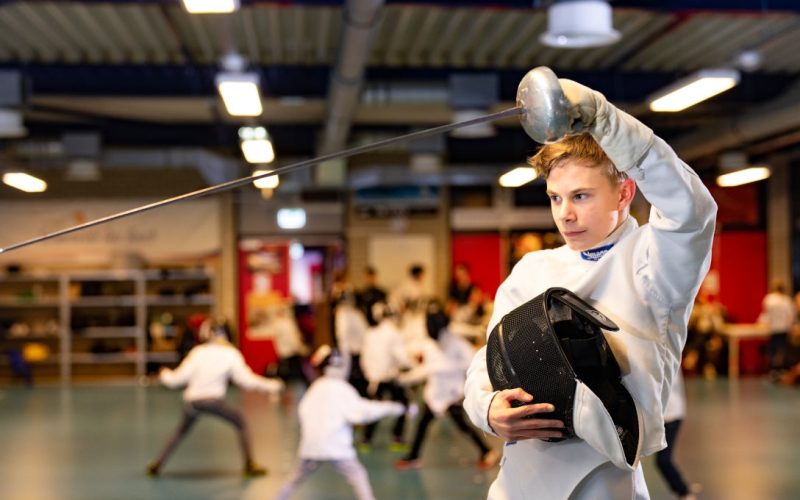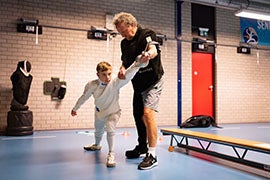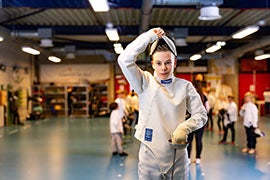From premature, fragile baby with a heart defect to 12-year-old boy cheering on rock bands like Muse and Metallica at a pop festival with his parents. Sverre Jansen had a difficult start, but thanks to high-quality medical care and close cooperation between pediatric cardiologists and physicians at the Wilhelmina Children’s Hospital (WKZ) and Máxima MC, he can now do many of the things his peers can do. “Since the summer, Sverre has been cycling to high school,” his parents tell us.
Only 1,200 grams weighed Sverre when he was born at Máxima MC in Veldhoven with Tetralogy of Fallot, a severe defect of the right half of the heart. Too little blood flowed to his lungs. Given his small, fragile body, it was still unclear whether the baby could be helped. After three weeks in the neonatology ward, Sverre’s condition worsened and he was rushed to the Wilhelmina Children’s Hospital (WKZ).
The team at the Utrecht Children’s Heart Center and referring doctors from Máxima MC decided on cardiac catheterization. That was Sverre’s only chance, because he was too light for heart surgery. “The cardiac catheterization was risky, but also necessary to keep Sverre alive,” says his mother, Mirjam Reinders. “Some more blood had to flow from the heart to the lungs again. Therefore, coronary stents were placed in the severe narrowing between the right ventricle and the pulmonary artery. The risky surgery succeeded and Sverre was given time to grow into the necessary heart surgery.” In the WKZ anno 2022, high-complex cardiac catheterization is even possible in patients weighing 700 grams.
For Sverre, the WKZ and Máxima MC would become a common thread in his life. Tetralogy of Fallot continues to require care. Father Theo Jansen recounts the three open-heart surgeries and eight catheterizations his son underwent after the first: “In his first year alone, there were three surgeries. The cardiac catheterization at 1,200 grams was followed by the first open-heart surgery to correct the construction defects in his heart. Sverre was then three months old. Then there were cardiac catheterizations aimed at removing a thrombus (blood clot that causes thrombosis, ed.). And later Sverre had open-heart surgery to remove scar tissue in his right ventricle, improving the blood supply from the heart to the lungs.”
Initially, Sverre and his parents lived in Den Bosch, then moved to nearby Rosmalen. For residents of this part of North Brabant, Máxima MC in Veldhoven is usually their “own hospital. If academic care is needed, a university medical center comes into the picture. So Sverre gets it at the WKZ and sees doctors at both hospitals. Theo: “In short: for check-ups, Sverre goes to the Máxima MC and in case of doubt or for highly complex care – such as the interventions on the heart – to the WKZ.”
Theo and Mirjam praise the cooperation between the hospitals. Mirjam: “If something comes to light during a check-up in Veldhoven that needs special attention, contact is made with the WKZ. It is teamwork. For example: what is needed at this moment for Sverre? And possibly: when should he be treated in the WKZ?”
She continues: “At Máxima MC, Christian Schroer is the regular doctor; he is a pediatrician with pediatric cardiology as his focus area. In the WKZ, we usually see pediatric cardiologist Gregor Krings. Those familiar faces, that makes it feel like a warm bath. Often we come back to one of the hospitals after a while, and we hear a doctor or a nurse: ‘Gosh Sverre, how big you’ve grown’. Sverre, Theo and I also feel part of the team. After a meeting of the medical specialists, we are updated and hear, for example, the pros and cons of the treatment the doctors recommend. The doctors tell Theo and me: we have the medical knowledge, but you see your child the most and know him best, so tell us how he is doing.”
Theo: “I also find it good to experience that medical specialists do not necessarily agree with each other. Interesting discussions are then held, with well-argued ideas. In my view, that can only lead to the best possible treatment result. Doctors strive for the very best.”
Sverre has had a heart valve inserted twice. The first time was through open-heart surgery. Four years later, the valve was too small and the time for replacement arrived. This was necessary because Sverre is growing and an artificial heart valve does not grow with him and gradually loses its function. The second time, the heart valve was inserted through the cervical vessels using 3D cardiac catheterization. Elsewhere in the world, this is done for patients weighing about thirty kilograms, but at the WKZ more is possible, and Sverre could be helped when he was only nineteen kilograms.
3D heart catheterization is a specialty of the pediatric heart center at the WKZ. The team has been at the forefront of this technique worldwide for more than a decade. Heart valves are inserted through the groin, oval stents are used so as not to obstruct the airway. Furthermore, 3D prints are used for the best possible surgical planning and ingenious techniques are used to achieve the most effective blood flow.
Mirjam: “Sverre will continue to grow, so there will come a time when another heart valve needs to be replaced. In order to signal such matters in time, he has been going for annual check-ups at Máxima MC since 2017. Should an intervention prove necessary, a visit to the WKZ follows.”
Care as much as possible in one’s own living environment, care further away if necessary. That is the idea behind shared care: two-way traffic between hospitals, where the child with a heart disease is central. The WKZ uses this formula not only in cooperation with Máxima MC, location Veldhoven, but also with St Jansdal (Harderwijk), Hospital Gelderse Vallei (Ede), Gelre hospitals (Apeldoorn) and St. Antonius Hospital (Nieuwegein), among others. The primary care provider is close by, so travel time often remains short: customized care and care close to home go hand in hand.
Theo: “For us, the distance to the Máxima MC in Veldhoven happens to be the same as the distance to the WKZ in Utrecht, but for others this set-up can be beneficial. In any case, we are happy with the cooperation between the hospitals. In both centers, the healthcare providers show great commitment; then it is also no objection to sometimes going to one hospital and sometimes to the other.”
His provisional last surgery Sverre underwent last year. Theo: “Our son developed pain in his leg because of a thrombosis he had had since he was a baby. With a cardiac catheterization procedure at the WKZ, the 11-year-old clot was dealt with and blood flow was restored in Sverre’s leg. The vein reopened, which reduced the acidification – fatigue – in his leg.” Mirjam: “Soon after, Sverre’s muscle mass and endurance increased. He could walk four instead of two kilometers before he got tired. Since the summer, he has been riding an electric bicycle up and down to his new school, where he is in the havo-vwo bridge class, every day. That’s two times five minutes. And like his peers, Sverre has hobbies. For example, he screens twice a week for an hour and a half, with rest periods in between.”
Making music is also a hobby. Mirjam: “Sverre has drumming lessons once a week and also practices at home. And this year the three of us went to Pinkpop for three days, where Imagine Dragons and Metallica, among others, played. During a day out, we always take a wheelchair with us. Sverre can sit in that to prevent him from getting tired. And if he wants to walk, he gets up from the chair and walks.”
Theo: “It is a reassuring thought that Sverre will remain in trusted and expert hands when he is an adult and will no longer be helped in the pediatric cardiac center of the WKZ. Via the Transition Center for Congenital Heart Defects, he will then be referred to cardiologists at the UMC Utrecht who specialize in adults with congenital defects.” Should Sverre have to undergo another catheterization or surgery in adulthood, he also sees his specialists from childhood again, who work closely with the adult cardiologists for this purpose.


